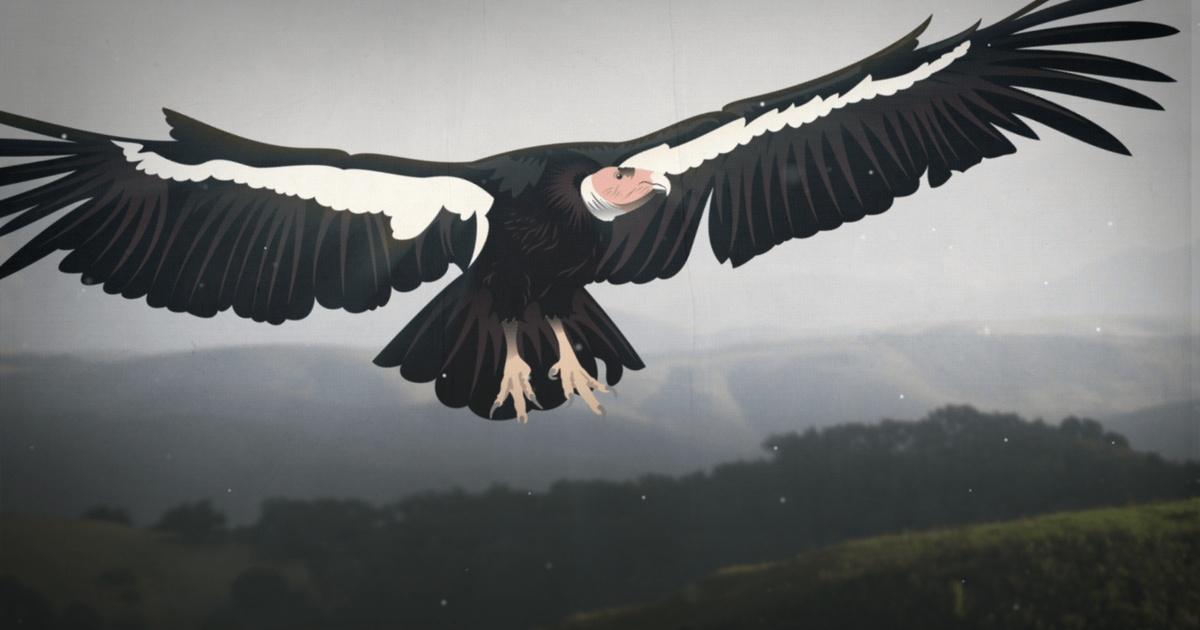
- Select a language for the TTS:
- UK English Female
- UK English Male
- US English Female
- US English Male
- Australian Female
- Australian Male
- Language selected: (auto detect) - EN
Play all audios:
I usually stand here and tell you about exotic creatures that you’re never gonna see -- extinct animals with unusual features, or strange body plans, or sizes that seem preposterous compared
to the animals we know today. But there are some organisms that live among us, even though they’re really better suited to life in the distant past. And if you’re lucky, you just might spot
them. One of these animals is the biggest flying bird in North America, a title that it’s held since the Late Pleistocene Epoch. It’s a giant of the skies that’s built to soar. Its wingspan
can reach almost 3 meters, and it can fly nearly half as high as the cruising altitude of a passenger jet. But this enormous, meat-eating bird doesn’t hunt. It’s a scavenger. It’s the
California condor, and to make ends meet, it feeds on the carcasses of large animals like elk or marine mammals that wash up on the Pacific coast. But, there are only a few hundred
California condors left on the entire planet. Which is kinda strange, because other, smaller scavenging birds are doing quite well: Ravens, vultures, and gulls have all had a much easier
time than the condor -- partly because they need less food, so they can survive on smaller scraps. So here’s a question: If the condor’s size means it needs more food, and that food
requirement is keeping it from thriving, then why is the condor so big to begin with? The answer lies in the fossil record. The California condor first appeared back in the Pleistocene, when
the world was a very different place. And what makes its survival so remarkable is it’s adapted to an ecosystem that no longer exists. The California condor is just one example of an
organism that we share the planet with today that seems lost in time, out of place in our world. To understand how weird and wonderful these organisms are, you have to understand what the
world used to be like, back in their heyday. And understanding that may be the key to securing their future. Scientists know the California condor as Gymnogyps californianus. It’s part of
the family of birds that includes the North American Turkey Vulture, the Black Vulture, and the Andean condor. These birds are often referred to as “New World vultures” because they all live
in North or South America. And the oldest fossil evidence for them in the New World is a specimen from Brazil that dates back about 25 million years. We’re not totally sure where this
family originated, but we have a pretty good idea of when. One genetic study has traced its origins to the Late Cretaceous or Early Paleogene period. And the family seems to have diversified
a lot in the middle Neogene Period, around 14 million years ago, which is also when we start seeing a lot of its fossils. And we think we know what the extinct members of this family ate,
because all of its modern members share a very specialized diet: They only eat carrion -- in other words: dead animals. As food sources go, carcasses might not seem all that appe aling, but
it does tend to be very reliable. And by eating the remains of dead animals, birds like vultures and condors help cycle nutrients back into the ecosystem, which is really important. Even the
family's scientific name, Cathartidae, comes from the Greek word for "purifier". And back in the Pleistocene, the California condor had a whole lot of North America to
purify. These giant birds could be found from the West Coast all the way to Florida and New York. And this vast range provided them with a much bigger selection of food than they have today.
During the Pleistocene, condors feasted on the carcasses of the famous megafauna from that epoch, like mammoths, bison, and giant sloths. There’s even direct evidence of this in ancient
condor nests found in caves that still have the bones of of these giant mammals in them! One cave in the Grand Canyon, for example, turned up not only condor bones but also eggshell
fragments and the remains of horses, bison, mammoths, camels, and an extinct mountain goat. And nests aren’t the only fossil evidence we have of their eating habits. At the La Brea tar pits
in Los Angeles, fossil Condors are found alongside mastodons, horses, and bison. They were probably drawn to the decaying bodies stuck in the asphaltum and then got stuck themselves. So,
scientists think that the abundance of large animals in the Pleistocene -- and the carcasses they left behind -- were what allowed ancient Condors to reach their great size. In fact, being
so large probably offered an advantage. Their massive wings would’ve been a huge help in finding food. After all, they had a lot of ground to cover in search of carrion, and thanks to their
wingspan, condors today are known to fly up to 240 kilometers a day looking for food. The problem is, those giant sources of carrion, like mammoths and sloths, aren’t around anymore. And
that’s a big part of why condors are struggling to survive. Condors are examples of what’s known as a biological anachronism. They seem like they come from a different time, because they’re
adapted for an ancient ecosystem that has since disappeared. There are lots of examples of anachronisms around today, and many of them date back to the Pleistocene. And some of the most
obvious examples are found in plants. For instance, today’s domesticated squash, like pumpkins, are members of a genus known as Cucurbita. And they’re descended from wild squash that used to
be widespread in North America. But these wild squash have been on the decline since the end of the Pleistocene. It turns out that these wild varieties are so bitter, and sometimes even
toxic, that very few animals can eat them. But back in the Pleistocene, it seems that at least some megafauna could tolerate the toxins. Because, the seeds of these wild squash have been
found in deposits of mastodon poop. This means that mastodons, and possibly other large mammals, ate these fruits and then pooped out the seeds as they traveled, spreading them far and wide.
So today these squash are struggling to survive, like the condor, because they’re adapted to an ecosystem where megafauna were around to disperse their seeds. Another possible anachronism
is the North American Pronghorn -- which, by the way, is not an antelope but is actually more closely related to the giraffe! And just as the condor seems over-adapted to its environment
because of its huge size, the pronghorn is just way faster than it needs to be. It can run at up to a hundred kilometers an hour, which is much, much faster than any living predator in North
America can run. But, if you lo ok in the fossil record, during the Pleistocene, pronghorn may well have needed that speed. Because it lived alongside members of the feline genus
Miracinonyx, which is sometimes called the North American Cheetah. There’s currently no fossil proof that Miracinonyx hunted Pronghorn. But some researchers think that if Miracinonyx was
anywhere near as fast as modern cheetahs, then the Pronghorn’s speed would’ve made a whole lot more sense back then. So, for the wild squash, the pronghorn and the condor, the world changed
enormously when most of the megafauna disappeared in the Pleistocene. During this epoch, about 90 genera of mammal megafauna -- about 72% of them worldwide -- went extinct. In North America,
the main hypotheses for why this happened have to do with a warming climate, human predation, competition with humans for resources, or maybe all of these things put together. Either way,
by about 10 thousand years ago, the worst of the megafauna extinction was over, and without as many large animals to feed on, Condors started to disappear. The last fossils of Condors in the
Grand Canyon, for example, have been dated to around 10,000 years ago, which is very soon after most megafauna, like that mountain goat, went extinct in the area. But some Condors survived,
because it turned out they had options. The Pleistocene extinctions brought about the end of most North American megafauna -- but, only on land. Marine mammals weren’t affected. And they
turned out to be a key to the condor’s survival. Researchers have been able to study the chemistry of condor fossil bones, to learn what different populations of condors were eating, even
before the extinction began. And it seems that the condors that lived in California were able to eke out a living, because they could eat the carcasses of marine animals, as well as the
megafauna like mammoths and sloths. For example, one study looked at the ratios of nitrogen and hydrogen isotopes in the protein called collagen found in Condor bones from the La Brea Tar
Pits. And it found that the chemistry of the condors’ bones was more like that of marine birds, like Pelicans, and less like the terrestrial birds at La Brea, suggesting that the condors
were eating organisms that came from the sea. But similar studies of bones of inland condors, like the ones at the Grand Canyon, showed that those birds were entirely dependent on
terrestrial carrion. And, as it happens, so did the condors that once lived in Florida. Their bone chemistry also shows that they feasted on land animals instead of marine life -- maybe
because fewer large marine mammals wash up on shore in Florida than in California. So, once the megafauna started to disappear from North America, California’s condors were able to fall back
on their diet of dead marine mammals, while their cousins that lived inland and in the East eventually perished. But the troubles for the giant scavengers didn’t end there. In the 19th and
20th centuries, condors began to feel the effects of human encroachment. They ate the poisoned bait that ranchers left for coyotes. They ingested the lead from bullets that were left in
animals that had been hunted. They were also poached, and saw their habitat diminish as human populations grew. By 1982, there were only 23 condors on the entire planet. But then, we
intervened. In 1987 all remaining wild California condors were captured and put into a captive breeding program, making them extinct in the wild. In 1992, those condors and their offspring
were reintroduced, with the hope that they would re-establish populations in California. And another population of condors was re-introduced to its ancestral home of the Grand Canyon. In
1996, a half-dozen condors were reintroduced there, and now they number around 80. This time, there are no mammoths or giant sloths for them to feast on. But the Grand Canyon birds have
found new opportunities cleaning up the remains of other large animals, like elk, mule deer, bighorn sheep, and even domestic cattle. Today there are about 290 California condors in the wild
and about 170 in captivity, living from the Central Coast to Baja California. Paleontology has taught us a great deal about the condor, why it’s been facing extinction, and how it might
take for it to survive. And by studying other species like it, paleontologists have also learned a lot about how species are affected by changes in their ecosystems, like extinction events.
So today, thanks to a certain amount of luck and resourcefulness, these anachronisms still patrol the skies, circling around, searching for food, and serving as messengers to us






